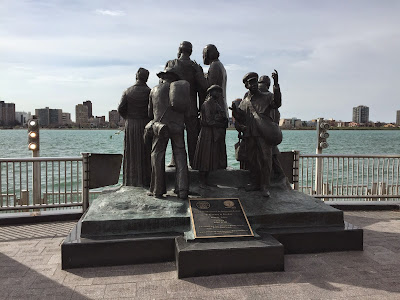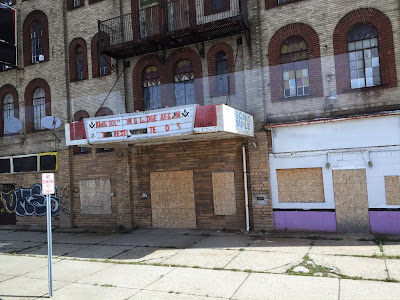This morning, my synagogue had a tour for 5th Graders, and optionally their parents, of Detroit historic Jewish locations. The kids are studying Jewish migration and patterns of living in Michigan.
We decided to come along on the tour.
The first stop was the riverfront to commemorate Jewish history in both the abolitionist movement and the Civil War.
We stopped at Hart Plaza and the Gateway to Freedom Statue.
The statute marks the underground railroad, across the river you can see the city of Windsor, Canada, where a companion statue, The Tower of Freedom can be found.
In the Civil War the 151 Jewish families in Michigan (about half of whom lived in Detroit) sent 181 men and boys off to fight, with 38 never to return home alive. Jews similarly served in excss of their proportion to their numbers of the population for both the North and South.
Next on the tour was Belle Isle - the Jewish connections include both the design and funding for the aquarium and the island's location as the first Fresh Air Camp in the area.
The aquarium is the oldest aquarium building still being used in the US. Built in 1904 and designed by Albert Kahn, it stayed open during both World Wars, and it was the oldest continually-operating aquarium in North America, only to be shut down in 2005 during the mayor-ship of the corrupt Kwame Kirkpatrick which ran the city out of money to operate it. Reopened in 2012 it is beginning to come back to its former glory bieng operated by volunteers.
The aquarium has its original green tile and skylights to give the impression of being in an underwater tunnel:
The view-ports for each tank are smaller than one would find in a modern aquarium, more small house-window sized rather than the massive and large tanks seen today.
Many of the tanks are still empty with much yet to be restored. Here's one tank without water but with items as a place filler:
After that, we headed to Chicago and Lawton Street, the location of the Fifth Shaarey Zedek synagogue (the prior ones being a home where the first congregation met and both it and the later buildings 2-4 having been destroyed over time and not accessible to visit). The Synagogue building is now turned into a church.
You can still see much of the Synagogue's original artwork and images untouched and well cared for since the buildings conversion into a church.
The menorah and inscription at the building's entrance:
The stained glass windows
The bima at the front of the sanctuary including where the ark used to be located:
The menorahs inside the sanctuary:
The bishop and church-goers had courteously let us tour the sanctuary before the start of their services and were warm and welcoming.
Then we went to another very historic Jewish area in the 1940s-1950s at Dexter and Davison streets. The area is far different today.
This Do Not Enter sign has multiple meanings:
A boarded up Masonic Temple:
This abandoned house bore a clear warning on its boarded-up windows:
The area is but a shadow of its former glory and most if not all traces of Jewish life there are gone.
It was a very interesting tour and I'm glad we could accompany the students on the tour.


















3 comments:
"historic Jewish area in the 1940s-1950s at Dexter and Davison streets."
My Mom was born a few blocks from there in the very early 1930's. Such nostalgia! I'm sure she would like to return there -- Not!
Yes I wouldn't advise walking around that area by yourself these days.
To say it has gone downhill is a serious understatement.
If I recall properly, Detroit has the Jewish community to thank for Sinai Hospital, a once-great medical institution, and also much of the medical staff of Henry Ford Hospital, which is ironic since Henry Ford was such a notable anti-semite.
Thanks for the nifty tour. Memories. Sigh.
Post a Comment